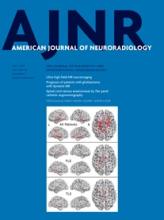Research ArticleNeurointervention
Narrowing the Expertise Gap for Predicting Intracranial Aneurysm Hemodynamics: Impact of Solver Numerics versus Mesh and Time-Step Resolution
M.O. Khan, K. Valen-Sendstad and D.A. Steinman
American Journal of Neuroradiology July 2015, 36 (7) 1310-1316; DOI: https://doi.org/10.3174/ajnr.A4263
M.O. Khan
aFrom the Biomedical Simulation Laboratory (M.O.K., K.V.-S., D.A.S.), Department of Mechanical and Industrial Engineering, University of Toronto, Toronto, Ontario, Canada
bCenter for Biomedical Computing (M.O.K., K.V.-S.), Simula Research Laboratory, Lysaker, Norway.
K. Valen-Sendstad
aFrom the Biomedical Simulation Laboratory (M.O.K., K.V.-S., D.A.S.), Department of Mechanical and Industrial Engineering, University of Toronto, Toronto, Ontario, Canada
bCenter for Biomedical Computing (M.O.K., K.V.-S.), Simula Research Laboratory, Lysaker, Norway.
D.A. Steinman
aFrom the Biomedical Simulation Laboratory (M.O.K., K.V.-S., D.A.S.), Department of Mechanical and Industrial Engineering, University of Toronto, Toronto, Ontario, Canada

REFERENCES
- 1.↵
- Meng H,
- Tutino VM,
- Xiang J, et al
- 2.↵
- Kallmes DF
- 3.↵
- Kallmes DF
- 4.↵
- 5.↵
- Pease AF
- 6.↵
- Valen-Sendstad K,
- Steinman DA
- 7.↵
- Valen-Sendstad K,
- Mardal KA,
- Steinman DA
- 8.↵
- 9.↵
- Schubert T,
- Santini F,
- Stalder AF, et al
- 10.↵
- Mortensen M,
- Valen-Sendstad K
- 11.↵
- Ferguson GG
- 12.↵
- Kurokawa Y,
- Abiko S,
- Watanabe K
- 13.↵
- Peiffer V,
- Sherwin SJ,
- Weinberg PD
- 14.↵
- 15.↵
- White CR,
- Stevens HY,
- Haidekker M, et al
- 16.↵
- Davies PF,
- Remuzzi A,
- Gordon EJ, et al
- 17.↵
- Fry DL
- 18.↵
- Ventikos Y
- 19.↵
- Roache PJ,
- Ghia KN,
- White FM
- 20.↵Journal of Fluids Engineering Editorial Policy. Statement on the Control of Numerical Accuracy. http://journaltool.asme.org/templates/JFENumAccuracy.pdf. Accessed September 1, 2014.
- 21.↵
- Hodis S,
- Uthamaraj S,
- Smith AL, et al
- 22.↵
- Steinman DA,
- Hoi Y,
- Fahy P, et al
- 23.↵
- Morinishi Y,
- Lund TS,
- Vasilyev OV, et al
- 24.↵
- Antiga L,
- Steinman DA
- 25.↵
In this issue
American Journal of Neuroradiology
Vol. 36, Issue 7
1 Jul 2015
Advertisement
M.O. Khan, K. Valen-Sendstad, D.A. Steinman
Narrowing the Expertise Gap for Predicting Intracranial Aneurysm Hemodynamics: Impact of Solver Numerics versus Mesh and Time-Step Resolution
American Journal of Neuroradiology Jul 2015, 36 (7) 1310-1316; DOI: 10.3174/ajnr.A4263
0 Responses
Jump to section
Related Articles
- No related articles found.
Cited By...
- Tube2FEM: a general-purpose highly-automated pipeline for flow related processes in (embedded) tubular objects
- Torrents of torment: turbulence as a mechanism of pulsatile tinnitus secondary to venous stenosis revealed by high-fidelity computational fluid dynamics
- 4D-CT angiography versus 3D-rotational angiography as the imaging modality for computational fluid dynamics of cerebral aneurysms
- Better Than Nothing: A Rational Approach for Minimizing the Impact of Outflow Strategy on Cerebrovascular Simulations
This article has not yet been cited by articles in journals that are participating in Crossref Cited-by Linking.
More in this TOC Section
Similar Articles
Advertisement











